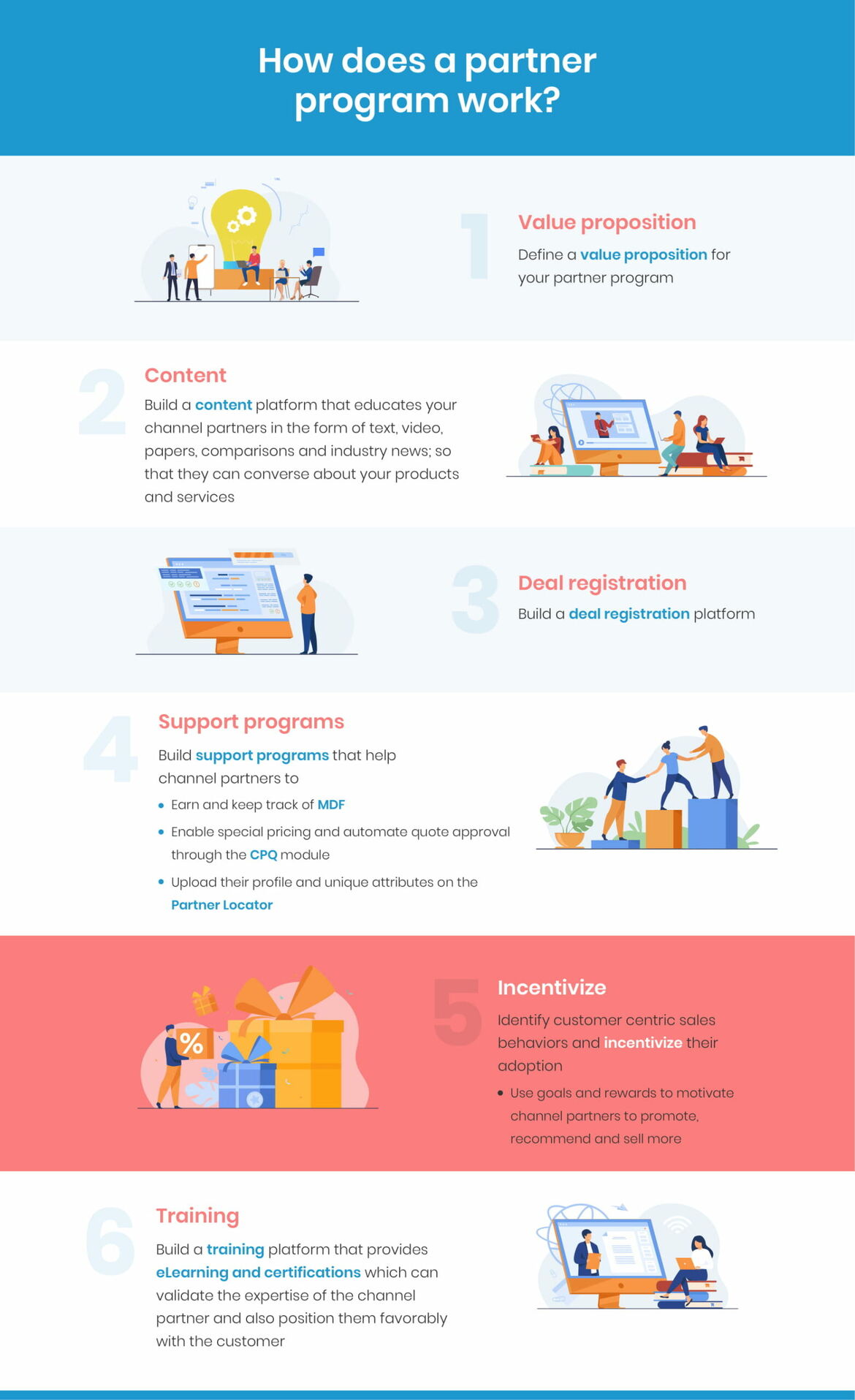Partner Programs – The Complete Guide
Partner programs are implemented because vendors want to do everything possible to enable and support their partners. A program works using a web-based portal and serves as the primary medium between both parties.
Within a partner program, there are generally 7 main pillars that make up the functionality.
1. Content
Partners gain access to content that has specific relevance to them. For example, product knowledge, product specifications, price lists. It becomes a great resource for keeping track of existing products or services, as well as any updates that may come from the supplier.
2. Business registration
Vendors often offer deal registration and allow partners to submit deal registration forms through the partner portal. The supplier will review the opportunity and, if approved, will prioritize that partner to close the deal.
3. Marketing development funds (MDF)
A program helps partners earn and track MDF, which is used to pay for materials and marketing activities to help promote the supplier's product.
4. Configure Price Quotation (CPQ)
The Configure Price Quote (CPQ) module enables special pricing and automatic quote approval for representatives and channel management team members.
5. Partner Locator
A feature that allows the partner to provide their unique profile and attributes so that customers can find them based on specific search criteria.
6. Training
Most programs provide some form of eLearning that could be like a course, white papers, sales roadmaps, competitor comparisons, and presentations. Since these become a critical pillar to help partners gain a deeper understanding of the supplier's offerings, which will help with customer interactions and sales.
7. Incentive program management
A partner program strategically utilizes goals and rewards designed to motivate partners to promote, recommend, and sell one or more products or services from a supplier.
Some companies consider incentives to be the main pillar of a program because it has the ability to drive sales and other desired goals (eg, leads, customer experience, product competency).
Why are incentives important in a partnership program?
Generally, companies associate incentives with organizational goals, such as sales goals. The reason it is considered by some to be the most important aspect of a partner program is because it leads to many great results and can boost many aspects of the sales process. For example, the criteria for completing an incentive could be based on:
Sell a specific amount of product within a quarter or a year
Achieve a revenue goal
Selling a set amount of a specific product
Sell a product in a certain period of time
Products sold to a specific market or vertical
If a partner meets the incentive criteria, they can be rewarded with discounts, points, funds and spiffs.
The key ingredient to building a successful partner program:
As we discussed in the previous section, the incentive pillar built into your program is extremely important and the examples in the section above show how companies use it to increase sales. But here's the secret that not many companies realize. What if you took the 7 pillars and looked at them in a different way?
You should look at incentives as a way to motivate partners to get involved with the other 6 pillars!
The fundamental reason this is important is that every aspect of a supplier program is based on partner actions (business registration, MDF spend, training) and every action is behavior-based.
When you encourage the right behaviors, you get the right results.
The important aspect is to select behaviors that not only encourage the achievement of your goal, but the behaviors that drive them – for example, if you want your partners to sell more of your product, you encourage the behaviors that lead to the sale. That means rewarding them for watching training videos, bringing in additional leads, or even sales funnel goals like giving a product demo.
Here are some examples of how to complement your program.
Contents
Getting all your partners to read about your products or services is critical for them to sell properly. For new members, why not reward them for downloading each of your white papers or watching all of your product videos?
- business registration
Encourage your dealers to record the deals they are looking for, which can give you a better forecast. In addition, it gives you the opportunity to reach individual value-added resellers (VARs) and offer assistance, education or more information that can close the deal. Encourage a partner for every deal they enter the portal. Or even better, encourage them towards a longer goal like submitting 100 deals within 90 days.
- Marketing development funds (MDF)
MDF funds can sometimes be underutilized by partners, so a great incentive strategy could be based on how much a partner organization spends on their marketing funds or even rewarding them for the percentage of allocated MDF they actually use (e.g. reward partners who allocate 40% of their funds to holding promotional events).
- Training
A partner can only sell large volumes of their product if they really understand how it works and why it can benefit a customer. For that, they need to undergo a significant amount of training about your product and the best way to sell it. Therefore, establish rewards for your partners who undergo a certain amount of training, such as product demonstrations.
So when behaviors are encouraged to spur more action, a program works more efficiently and effectively, leading to more sales and revenue. This mindset completely changes the way you think about building a partner program and will change the success you have as well.
Conclusion
As mentioned earlier, a partnership program is comprised of 7 critical pillars that are linked through a web-based portal:
- Contents
- business registration
- Marketing development funds (MDF)
- Configure Price Quotation (CPQ)
- partner finder
- Training
- Management of incentive programs
Incentives that are built into partner programs are a great tool and are considered the most important part because they have the ability to drive sales-related activities. The main function of an incentive is to help align organizational objectives with partner actions. But the secret to success is not just encouraging sales activities, but the other 6 pillars of a program. Partners will be more motivated to work toward the company's goals and will be rewarded for being active participants in a program.
Remember that every action of a partner is based on behavior and you should be creating incentives that not only encourage the achievement of your goal but the behaviors that drive them.
The channel partner/provider relationship can get quite complicated, which is why creating a channel partner program is not only efficient but also powerful. Even some of the biggest manufacturing and technology companies, including Microsoft, VMWare Caterpillar, and thousands of others, have invested their time and money in building one. According to Crossbeam, 93.1% of organizations said the partnerships they've created have a measurable impact on revenue. Additionally, in 61.1% of these organizations, leadership considered channel partner leaders to be their peers.
Despite all the positives, creating a successful one can be difficult to execute. It takes time, effort, and most importantly, strategic planning.





